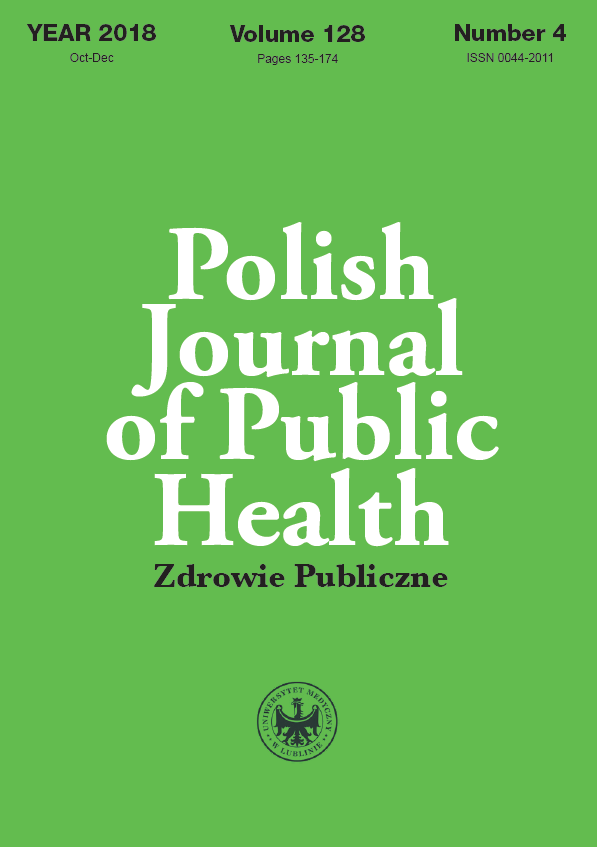Fats in women’s diet and everyday life
DOI:
https://doi.org/10.2478/pjph-2018-0030Keywords:
women , dietary fats, diet, everyday lifeAbstract
Introduction. Currently, vegetable oils are used not only for consumption but also for medicinal and cosmetic purposes. They are especially eagerly used by women, although their knowledge in this field is usually insufficient.
Aim. The aim of the study was to determine the dietary habits of women and to analyse the importance and position of vegetable fats in their diet and life. Another objective was to assess the level of knowledge and awareness of the health-enhancing properties of these products.
Material and methods. The study involved women (n=253) aged 18-30, 31-40, and over 40 years living in Lubelskie Province, Poland. The modified questionnaire was composed of questions about their diet, regularity of meals, habits and preferences of fat intake, and motivation behind including fats in the diet or for cosmetic or medicinal applications.
Results. Approximately 45% of the respondents sometimes used fats with their meals and 23% used them regularly. Fats were consumed by approximately 86% of the total number of respondents and were used for medicinal and cosmetic purposes by ca. 15.5 % and 6% of the respondents, respectively. Linseed oil (34%) and coconut oil (27%) were regarded as the most valuable fats. Butter and rapeseed oil were consumed most frequently (p<0.05). Approximately 47% of the respondents regarded refined oils as valuable products, and 40% of the respondents were aware of the harmful effects of trans fats.
Conclusion. The survey indicates a necessity of implementation of educational campaigns among consumers in order to disseminate the knowledge about the role of fat in the diet and the risks associated with excessive consumption and poor quality of these products
References
1. Sacks FM, Lichtenstein AH, Wu JH, et al. Dietary fats and cardiovascular disease: a presidential advisory from the American Heart Association. Circulation. 2017;136(3):e1-e23.
2. Cichosz G, Czeczot H. Kwasy tłuszczowe izomerii trans w diecie człowieka. Bromat Chem Toksykol. 2012;45.2:181-90.
3. Jarosz M, Rychlik E, Stoś K, et al. Normy żywienia dla populacji Polski. Instytut Żywności i Żywienia; 2017.
4. Feranil ABP, Duazo L, Kuzawa CW, Adair LS. Coconut oil predicts a beneficial lipid profile in pre-menopausal women in the Philippines. Asia Pac J Clin Nutr. 2011;20(2):190-5.
5. Kondratowicz-Pietruszka E, Białek J. Współczesny rynek tłuszczów ze szczególnym uwzględnieniem obrotu towarowego tłuszczami roślinnymi. Zesz Nauk UE w Krakowie. 2015;918:51-69.
6. Stupnicki R. Analiza prezentacja danych ankietowych. Warszawa: Wyd. AWF; 2003. p.12-45.
7. Rampersaud GCPM. Breakfast habits, nutritional status, body weight, and academic performance in children and adolescents. J Am Diet Assoc. 2005;743-60.
8. Ramotowska A, Szypowski W, Kunecka K, Szypowska A. Ocena czynników wpływających na konsumpcję śniadań wśród warszawskiej młodzieży w wieku szkolnym – rola w prewencji otyłości. Endokrynol Ped. 2017;58:33-40
9. Szajewska H, Ruszczyński M. Systematic review demonstrating that breakfast consumption in fluences body weight outcomes in children and adolescents in Europe. Crit Rev Food Sci Nutr. 2010;50:113-9.
10. Korzeniowska-Ginter R, Czarniecka-Skubina E. Wykorzystanie tłuszczów do przygotowania potraw smażonych w warunkach domowych. Brom Chem Toksykol. 2012;(45.3):1117-22.
11. Waśkiewicz A, Piotrowski W, Szostak-Węgierek D, Cicha-Mikołajczyk A. Relationship between 28-year food consumption trends and the 10-year global risk of death due to cardiovascular diseases in the adult Warsaw population. Kardiol Pol. 2015,73(8):650-5.
12. Popis E, Ratusz K, Przybysz M, Krygier K, et al. Światowa oraz polska produkcja lnu oleistego i oleju lnianego. Zesz Nauk SGGW w Warszawie. Probl Rol Światowego. 2015;15(2):106-16.
13. Eyres L, Eyres MF, Chisholm A, Brown RC. Coconut oil consumption and cardiovascular risk factors in humans. Nutr Rev. 2016;74(4):267-80.
14. Jessa J, Hozyasz KK. Wartość zdrowotna produktów kokosowych. Pediatria Pol. 2015;90(5):415-23
15. US Department of Health and Human Services. Dietary guidelines for Americans 2015-2020. Skyhorse Publishing Inc; 2017.
16. Onacik-Gür S, Żbikowska A, Kowalski M. Źródła izomerów trans kwasów tłuszczowych na polskim rynku. Probl Hig Epidem. 2014;95(1):120-4.
17. Kiczorowska B. Nowoczesne technologie przetwórstwa żywności pochodzenia roślinnego – korzyści i zagrożenia zdrowia konsumenta. In: M. Skrzypek, T. B. Kulik (eds). Dietetyka praktyczna w ujęciu interdyscyplinarnym. Lublin: Wydawnictwo KUL; 2016. p.101-13.
18. Zychnowska M, Pietrzak M, Krygier K. Porównanie jakości oleju rzepakowego tłoczonego na zimno i rafinowanego. Zesz Probl Postęp Nauk Rol. 2013;575:131-8.
19. Waśkiewicz A. Jakość żywienia i poziom wiedzy zdrowotnej u młodych dorosłych Polaków – badanie WOBASZ. Probl Hig Epidem. 2010;91(2):233-7.
Downloads
Published
Issue
Section
License
Copyright (c) 2019 Polish Journal of Public Health

This work is licensed under a Creative Commons Attribution-NonCommercial-NoDerivatives 3.0 Unported License.


